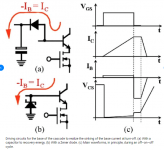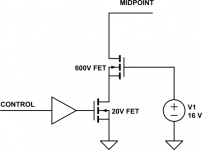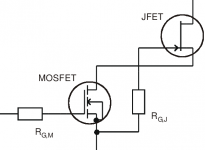DIYA is full of impractical amps. But they can always claim they provide the sound they want. There are multi-tier class D amps that push for a yet better efficiency. Switching amps do have RF noise issues. And there are self-oscillating and clocked class-D vs the typical PWM, and dead-time issues. Class-H can be relatively simple.Sorry for taking you back , but just curious why you designed class h 3tier with all complexity instead of just designing a class d with two output fets and using +/-160vlts power supply, ???
thanks for the reply steveu , but complexity of power supply complicates class h . class d can give the same power with less complexity and components of class h or class tdDIYA is full of impractical amps. But they can always claim they provide the sound they want. There are multi-tier class D amps that push for a yet better efficiency. Switching amps do have RF noise issues. And there are self-oscillating and clocked class-D vs the typical PWM, and dead-time issues. Class-H can be relatively simple.
I had designed Class-H upto 4th Tier as well, but that was way back in 2011 till 2013, after that I have switched to Class-D and its derivatives.Sorry for taking you back , but just curious why you designed class h 3tier with all complexity instead of just designing a class d with two output fets and using +/-160vlts power supply, ???
The real problem is that scalability in class D is not as simple as it appears. At +/-160 volts your can’t get away with just two FETs - 400 volt mosfets have too high an RDS(on) and you resort to the same massive paralleling as you do with class H. Then you have the problem of keeping all that spread out circuitry synchronized down to the nanosecond. In class H it doesn’t have to be, in class D the switching losses skyrocket unless you do. It’s not impossible to do, but it is complicated and more importantly a very expensive iterative process to get a reliable product. Class H amps work the first time. In SUBWOOFER only application like much of the car audio, you can drop the switching frequency to just above audio and put in a 2 us dead time, then you could pretty much just throw it together. Forget about the fidelity you’d expect from a modern PA amp.Sorry for taking you back , but just curious why you designed class h 3tier with all complexity instead of just designing a class d with two output fets and using +/-160vlts power supply, ???
I’m not saying you can’t build a class D that can do +/-160 volts at +/-110 amps with 40 KHz sine wave capability at 0.1% distortion. But don’t just set out to “design” one and expect to be done in a month. Expect it to take a year with no full time job to get in the way and incur about $10k in development cost. The second one will be a little easier. There is a REASON that 15 pound 10kW touring grade PA amps cost $5k and up. There is a reason the sub-$1k ones are as cheap as they are - they top out with power supplies under +/-100 volts so they can just use a “chipset“ to drive single pairs of low RDS mosfets, and just copy a basic reference design from IR.
I‘m sure workhorse had some fires along the way between 2011 and today, and already had a substantial investment in lab equipment before going into it.
hi Kasd thanks so much for the reply , please share the link of your class d build developmentI had designed Class-H upto 4th Tier as well, but that was way back in 2011 till 2013, after that I have switched to Class-D and its derivatives.
i am in a dilemma , between class td or h 3tier and class d . my big issue is that what is more reliable between class h , td and class d ??
Last edited:
thanks ski for the reply , my issue is that component count of class td and h at +/-160vlts is a lot of components are usedThe real problem is that scalability in class D is not as simple as it appears. At +/-160 volts your can’t get away with just two FETs - 400 volt mosfets have too high an RDS(on) and you resort to the same massive paralleling as you do with class H. Then you have the problem of keeping all that spread out circuitry synchronized down to the nanosecond. In class H it doesn’t have to be, in class D the switching losses skyrocket unless you do. It’s not impossible to do, but it is complicated and more importantly a very expensive iterative process to get a reliable product. Class H amps work the first time. In SUBWOOFER only application like much of the car audio, you can drop the switching frequency to just above audio and put in a 2 us dead time, then you could pretty much just throw it together. Forget about the fidelity you’d expect from a modern PA amp.
I’m not saying you can’t build a class D that can do +/-160 volts at +/-110 amps with 40 KHz sine wave capability at 0.1% distortion. But don’t just set out to “design” one and expect to be done in a month. Expect it to take a year with no full time job to get in the way and incur about $10k in development cost. The second one will be a little easier. There is a REASON that 15 pound 10kW touring grade PA amps cost $5k and up. There is a reason the sub-$1k ones are as cheap as they are - they top out with power supplies under +/-100 volts so they can just use a “chipset“ to drive single pairs of low RDS mosfets, and just copy a basic reference design from IR.
I‘m sure workhorse had some fires along the way between 2011 and today, and already had a substantial investment in lab equipment before going into it.
ooh wow , never thought of it that way , thanks for the heads up.To me the number of components is almost irrelevant. How easy they are to specify, source, place, and route determines the complexity of a design.
The real problem is that scalability in class D is not as simple as it appears. At +/-160 volts your can’t get away with just two FETs - 400 volt mosfets have too high an RDS(on) and you resort to the same massive paralleling as you do with class H. Then you have the problem of keeping all that spread out circuitry synchronized down to the nanosecond. In class H it doesn’t have to be, in class D the switching losses skyrocket unless you do. It’s not impossible to do, but it is complicated and more importantly a very expensive iterative process to get a reliable product. Class H amps work the first time. In SUBWOOFER only application like much of the car audio, you can drop the switching frequency to just above audio and put in a 2 us dead time, then you could pretty much just throw it together. Forget about the fidelity you’d expect from a modern PA amp.
I’m not saying you can’t build a class D that can do +/-160 volts at +/-110 amps with 40 KHz sine wave capability at 0.1% distortion. But don’t just set out to “design” one and expect to be done in a month. Expect it to take a year with no full time job to get in the way and incur about $10k in development cost. The second one will be a little easier. There is a REASON that 15 pound 10kW touring grade PA amps cost $5k and up. There is a reason the sub-$1k ones are as cheap as they are - they top out with power supplies under +/-100 volts so they can just use a “chipset“ to drive single pairs of low RDS mosfets, and just copy a basic reference design from IR.
I‘m sure workhorse had some fires along the way between 2011 and today, and already had a substantial investment in lab equipment before going
Then you have the problem of keeping all that spread out circuitry synchronized down.
Thats no problem, very easy with self oscillating amp to synchronized circuitry
At +/-160 volts your can’t get away with just two FETs - 400 volt mosfets have too high an RDS(on)
Yes thats true, but problem solved due cascoded Mosfet driving +/-170 V DC without issues
hey malta do you have a link on a forum about cascoded fet driving in a class d amplifier? kindly shareThats no problem, very easy with self oscillating amp to synchronized circuitry
Yes thats true, but problem solved due cascoded Mosfet driving +/-170 V DC without issues
also is cascode driving of fets any advantage on kasd class h or any class h amp?
Attachments
Last edited:
Reliability has nothing to do with class of operation. I got success and failure in almost every class I have tried. Class-H is simpler than Class-D, TD is somewhat in between but it has its own pros and cons, you cannot run high frequency signals such as 10khz-15khz sinewaves alone in Class-TD with asynchronous buck converter steps without failure of output stage because the rails do not follow the signal envelope, Since there is no active discharging of rail capacitances associated with buck converter output. For that you need synchronous buck converter step which again is nothing but a class-D stage. Choose your poison wisely.hi Kasd thanks so much for the reply , please share the link of your class d build development
i am in a dilemma , between class td or h 3tier and class d . my big issue is that what is more reliable between class h , td and class d ??
I have a question please, On the schematic for the H900 the schematic seems to indicated that the anode of D7 goes to "FB" which I am assuming is feedback.
Does this mean it needs to be connected before or after R19, i.e. on the output side or the opamp side?
With thanks,
Does this mean it needs to be connected before or after R19, i.e. on the output side or the opamp side?
With thanks,
As well as any other cheap PA amplifier. The problem isn’t the sound quality. With that series QSC joined the ranks of every other company that’s been cheaping out. If you analyze it, it runs everything in it HARDER at 4 ohms than the old RMX2450 did at 2 ohms. So take the 2450 and run five speakers in parallel per channel, and get the same useful life out of the GX5 running just two per channel.bump... i have a QSC GX5 which is a 2-tier class H and am wondering how well it reproduces the signal
I only run a single pair of 2” compression drivers (8 ohm per channel) with the one I have. In my B rig.
- Home
- Amplifiers
- Solid State
- The Class - H Amplifier


